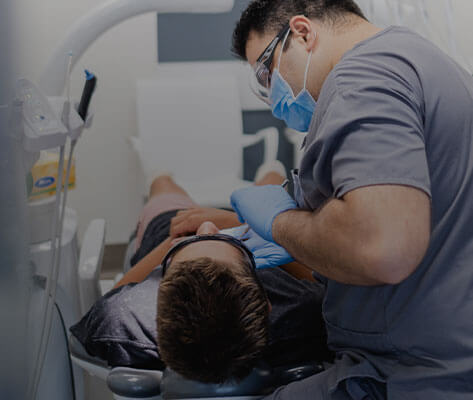new patient questions
braces use steady, gentle pressure to gradually move teeth into new positions. The main components of braces are the brackets (the individual metal device that is bonded to each tooth) and the archwire (the wire which connects the brackets together). There is one archwire for the upper teeth and one archwire for the lower teeth. The archwire is attached to the brackets and exerts force on the tooth as the wire tries to return to its original shape. This pressure moves the teeth to a new, more ideal position.
Phase I, or early interceptive/preventive treatment, is limited orthodontic treatment (that is, treatment with just expanders, partial braces, and/or functional plates). Such treatment can occur between the ages of 6 and 10. This treatment is sometimes recommended to make more space for developing teeth or to correct a cross-bite, overbite, underbite, or a harmful oral habit, like thumb-sucking.
Phase II treatment (also called comprehensive treatment) involves full braces or aligners and occurs after all the permanent teeth have erupted.
At your first visit, we complete a comprehensive evaluation of your teeth, jaws, and gums. We take measurements and diagnostic records, including photographs of the teeth and face, x-rays, and, if required, models of the teeth. We discuss the need for orthodontic treatment, appropriate treatment options, length of treatment, when to begin treatment, cost, and financial arrangements.
The length of treatment varies on a case-by-case basis, but the average treatment length is from 12 to 18 months. Actual treatment time can be affected by the rate of bone growth and the severity of the correction needed. Treatment length is also dependent on patient compliance. Maintaining good oral hygiene, visiting your dentist for regular cleanings, and keeping your orthodontist appointments are all important ingredients for keeping your treatment on schedule.
Placing bands and brackets on your teeth does not hurt. But once your braces are in place and the archwire is connected to the brackets, you may feel some tenderness of your teeth for 1-4 days. Your lips and cheeks may feel irritated by the wire and brackets, as well. We have a number of ways to deal with this discomfort.
No. However, we recommend that athletes protect their teeth by wearing a mouldable mouth guard while playing sport. Mouth guards are inexpensive and comfortable. For musicians, there may be an initial period of adjustment after you get your braces on. There are also mouth guards specifically designed for musicians. We can recommend a company where you can purchase one of these.
Yes, you should see your dentist every 6 months for cleaning and check-ups.
The cost of treatment varies on a case-by-case basis depending on the specific corrections needed, treatment length, and type of braces. We will discuss fees and payment options with you prior to treatment. We offer a number of payments plan to suit different budgets. We work hard to make orthodontics affordable, and we accept cash, EFTPOS, Visa, MasterCard, and American Express.
Currently, tax rebates are available for dental and orthodontic treatments. Please check with your accountant to determine if you are able to claim this on your tax return.
Many of our patients have regular obligations (work, school) during the day, so we offer many appointments in the early morning and late afternoon. These appointments are for shorter treatment needs, such as progress adjustments and checks. During treatment, you will need to come in every 8 to 12 weeks for these types of appointments.
For longer appointments, such as initial assessment, banding, and bonding, we typically schedule during the day. By doing this, we can accommodate as many patients as possible in the hours that don’t conflict with school and work. If you prefer to be seen during a quieter time for your progress checks, please schedule an appointment during school/work hours.
We realise that once in a while unforeseen circumstances arise which will require you to change your appointment or cause you to overlook your appointment. We will do our best to reschedule your appointment as soon as possible so progress is not lost. If you arrive late, we may need to reschedule your appointment in fairness to other patients. Please let us know at least 24 hours prior to a cancellation to avoid a cancellation fee of $25.
Yes. With the sunshine coast offering an array on public transport option, there is a bus stop approximately 125m from the practice on the southbound sector and around 10m on the northbound sector.
Our Team of assistants are highly trained with the necessary skills and qualifications. The Staff obtain a Certificate III in Dental Assisting via vendors including TAFE and professional associations. Our practice also provides intensive training to ensure the staffs are ready to see patients, prior to commencement of job role.
Spark is an orthodontic treatment method that uses clear aligners to straighten your teeth. Custom made for each patient; Spark aligners are designed to your specifications using specialised methodology and cutting-edge technology. Each aligner is produced with machine precision and then hand-finished and refined in Spark’s state-of-the-art laboratories to ensure a completely customised, one of a kind appliance for you.
This is dependent on the complexity of the case but on a payment plan it’s very little different. About $5-$10 per week more usually to get clear aligners compared to braces.
We try and tailor make your payment plan to suit your budget. You can decide if you would like to put down a larger deposit and pay it off quicker or a smaller deposit and pay it at your pace.
No. If you do have one, we can provide further information to make payment easy. Usually, obtaining a new subscription for health fund for orthodontics is not recommended as health funds would charge an additional charge per month, and in return the maximum claimable amount is no more than $800 per year.
There are an array of discounts and promotions that are offered. All of these are promoted via social media, so please watch our Facebook, Instagram or YouTube channels.
Visit us without needing a referral! However, we kindly request a letter of dental fitness from your primary dentist, dated within the past 6 months, before your consultation.
Yes. We provide parking at the back of the practice with disabled parking at the front of the practice.
Yes. Appointments start as early as 8.30am up to 5.00pm on Wednesdays and Fridays. On Thursday afternoons we are open for late night until 6.00pm.
Your consultation at Invisible Orthodontics will cost $49 for patients under 18 and $200 for adults. These costs cover any dental records we need to take - including photos and x-rays - and the extra will be deducted from the overall cost of treatment should you decide to proceed.
Not only are our fees comparable to general dentists, we offer interest-free payment plans from $75 per week.
We are one of the few practices in Australia that offers no deposit payment plans. Our aim is to facilitate hassle free payment plans with less upfront amount.
Orthodontists and dentists share many similarities – they work together to help you improve your overall oral health – but they actually work in very different ways. Dentists cover a broad range of oral health issues. An orthodontist, on the other hand, is a dental specialist with a singular focus: straightening teeth and aligning jaws. An orthodontist has been trained exclusively on teeth straightening via three additional years of training, and most importantly tested/examined. General dentists can learn about teeth straightening, but they have never been tested/examined by peers.
Placing bands and brackets on your teeth hurts lot less than you imagine. Once your braces are in place and the archwire is connected to the brackets, you may feel some tenderness of your teeth for 1-4 days. Your lips and cheeks may feel irritated by the wire and brackets, as well. We have a number of ways to deal with this discomfort. Watch our YouTube channel for tips and tricks.
One problem that is addressed at this age is teeth crowding. After an examination, Dr Vas can tell whether a child’s mouth will be able to accommodate all of his or her adult teeth in the future. If not, we can work to expand the jaw now using an expansion appliance. This means no teeth will need to be extracted later.Dr. Vas specializes in treatment techniques that requires no removal of adult teeth in most circumstances.
Yes. Toilets are provided within the practice, with a disabled toilet and change tables for children and families.
Yes. There is disable parking and bathrooms available.
We offer late night appointments on a Thursday evening to 6.00pm.
Dr Vas recommends young children be evaluated by an orthodontist by the age of 7. This is the age recommended by international orthodontic associations. There is no upper limit for treatment. As long as you have healthy gums and bones, Dr. Vas can move your teeth well.









